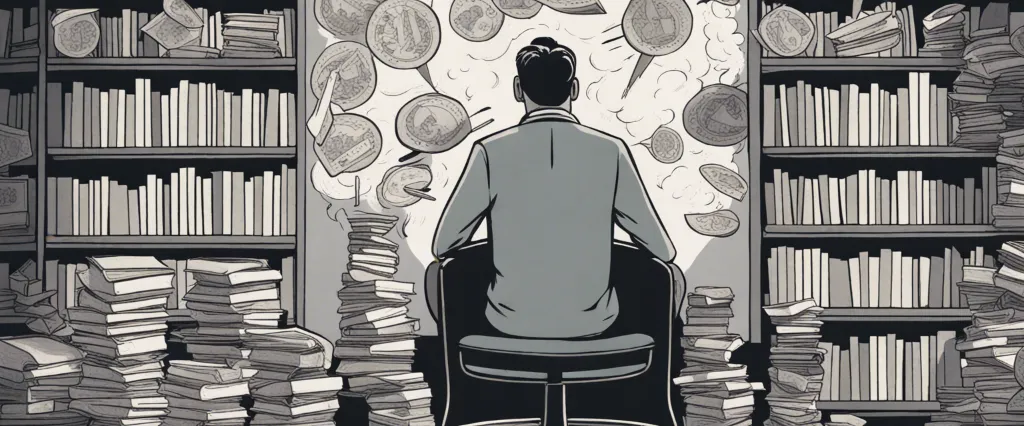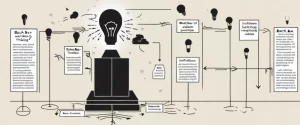——Good Economics for Hard Times by Abhijit V. Banerjee & Scarcity by Sendhil Mullainathan

In the realm of economics, where answers to pressing global issues often elude us, two influential scholars have risen to the challenge and offered their unique perspectives on how to tackle hard times. Abhijit V. Banerjee, a Nobel laureate, and Sendhil Mullainathan, a renowned behavioral economist, have individually penned books that seek to shed light on the intricate workings of scarcity and its impact on our societies. In Banerjee’s “Good Economics for Hard Times” and Mullainathan’s “Scarcity,” both authors delve into the complex interplay between economics and scarcity, exploring the consequences and potential solutions for the challenges we face in an increasingly turbulent world.
Banerjee, celebrated for his pioneering research in development economics, provides readers with a fresh and optimistic lens in “Good Economics for Hard Times.” Through empirical evidence and thoughtful analysis, he delves into the pressing issues of inequality, immigration, and technological disruption that shape our modern lives. Banerjee argues for the power of rigorous economic research in tackling these challenges head-on, offering insightful counterarguments to prevailing assumptions and policies. Drawing on his experiences studying poverty and social welfare across the globe, Banerjee weaves personal anecdotes with robust economic analysis, resulting in a thought-provoking exploration of how economics can enlighten and transform our understanding of hard times.
Complementing Banerjee’s work, Mullainathan’s “Scarcity” takes a closer look at the intricate relationship between scarcity and human behavior. Drawing on a blend of behavioral economics and psychology, Mullainathan explores the wide-ranging consequences of scarcity and the ways in which it affects our decision-making processes. By delving into the psychology of scarcity, Mullainathan intricately examines how the scarcity mindset can perpetuate a cycle of disadvantage and limit individuals’ ability to make informed, rational choices. Through vivid examples and compelling research, he challenges conventional wisdom and offers practical strategies to overcome scarcity’s grip on our lives, ultimately providing a roadmap for individuals and policymakers to combat its adverse effects.
Despite their shared focus on scarcity and economics, these two books offer distinct approaches and perspectives. Banerjee’s “Good Economics for Hard Times” takes a wide-angle view, examining the influence of economic forces on global issues, while Mullainathan’s “Scarcity” analyzes how scarcity shapes individual behavior and decision-making. Together, these works not only shed light on the complexities of scarcity but present a nuanced exploration of the challenges and potential solutions that lie ahead. By synthesizing economic theory, empirical evidence, and real-world experiences, both Banerjee and Mullainathan prompt readers to critically examine the role of scarcity in our lives and propose innovative ways to navigate hard times.
Brief Summary of Two Books
Good Economics for Hard Times by Abhijit V. Banerjee
Good Economics for Hard Times” is a book written by Abhijit V. Banerjee and Esther Duflo, two Nobel laureates in economics, that seeks to address some of the pressing economic issues faced by societies today. The book focuses on debunking common myths and misconceptions surrounding topics such as immigration, inequality, and climate change that often lead to ineffective or harmful policies.
Banerjee and Duflo argue for an evidence-based approach to economic policymaking, emphasizing the importance of empirical research and data analysis to understand complex economic problems and find practical solutions. They challenge the prevailing notions about immigration and demonstrate how it can have positive economic impacts, both for the host countries and the migrants themselves.
In the context of inequality, the authors examine the causes and consequences of widening income disparities. They propose policies such as social safety nets, redistribution, and investment in basic public services as ways to address inequality and create a more equitable society. Furthermore, they explore the factors contributing to a lack of jobs and skills mismatch, and suggest interventions like vocational training and job creation programs to tackle unemployment.
Additionally, Banerjee and Duflo delve into the issue of climate change, analyzing the economic aspects of environmental degradation and the potential effectiveness of various policies in curbing harmful practices. They emphasize the need for collective action and international cooperation to mitigate the adverse effects of climate change.
Overall, “Good Economics for Hard Times” offers a fresh perspective on some of the most critical economic challenges of our time. It provides readers with a deeper understanding of these issues, challenges conventional wisdom, and presents evidence-based solutions to foster prosperity and social well-being.
Scarcity by Sendhil Mullainathan
Scarcity: Why Having Too Little Means So Much” written by Sendhil Mullainathan and Eldar Shafir explores the psychological and behavioral impact of scarcity on individuals and societies. The book argues that scarcity, whether it is a shortage of time, money, or any other resource, affects our decision-making abilities and traps us in a scarcity mindset.
Mullainathan and Shafir present various studies and real-life examples to demonstrate how the scarcity mindset affects our cognitive abilities, focusing on the cognitive load that scarcity imposes on our brains. They explain that when we are under scarcity, our attention narrows, making us unable to focus on anything other than the scarcity itself. This tunnel vision leads to poor decision-making, impaired self-control, and increased stress levels.
The authors also discuss the cyclical relationship between scarcity and poverty, highlighting how individuals in poverty are constantly stuck in a scarcity trap due to the cognitive effects of scarcity. They argue that the scarcity mindset perpetuates poverty as it hinders the ability to plan for the long term and make optimal decisions.
Furthermore, the book provides practical strategies for mitigating the negative effects of scarcity. It suggests that designing better systems and policies that alleviate scarcity can have significant positive impacts on individuals and society as a whole. Mullainathan and Shafir propose interventions that target the cognitive overload caused by scarcity, such as simplifying complex tasks and providing buffers to mitigate unexpected scarcity shocks.
In summary, “Scarcity” is a thought-provoking exploration of how scarcity shapes our thinking and behavior. It sheds light on the hidden costs of scarcity and offers potential solutions for individuals, organizations, and policymakers to address and mitigate the negative ramifications of living in a state of scarcity.
Comparison between Two Books

Similarities in Economics
Both “Good Economics for Hard Times” by Abhijit V. Banerjee and “Scarcity” by Sendhil Mullainathan revolve around the field of economics and address various challenges and issues faced by individuals and societies.
1. Focus on Real-World Problems: Both books prioritize addressing real-world problems and challenges faced by individuals, communities, and economies. They strive to connect economic theories and concepts to the experiences of everyday people, making the subject matter accessible and relatable.
2. Emphasis on Behavioral Economics: Both books delve into the field of behavioral economics, which analyzes how human behavior affects economic decisions. They explore the psychological factors influencing choices and actions, shedding light on why individuals make certain decisions and how these decisions impact broader economic systems.
3. Importance of Empirical Evidence: “Good Economics for Hard Times” and “Scarcity” rely on empirical evidence to support their arguments and conclusions. They draw on data from various studies and experiments to analyze economic phenomena and validate their hypotheses.
4. Exploration of Inequality and Poverty: Both books shed light on issues of inequality and poverty and their implications for economic well-being. They examine the causes and consequences of these societal challenges and present potential solutions to mitigate their effects.
5. Policy Recommendations: In both books, the authors provide policy recommendations based on their analyses and research. They propose practical, evidence-based solutions to address economic problems and promote inclusive growth.
6. Clarity and Approachability: Both “Good Economics for Hard Times” and “Scarcity” are written in a clear and approachable manner, making complex economic concepts understandable to a wide range of readers. The authors use plain language and real-life examples to convey their ideas effectively.
While these books address similar themes in economics, it’s important to note that they approach the subject from different angles. “Good Economics for Hard Times” focuses on the broader challenges faced by economies, governments, and societies, while “Scarcity” explores the psychological and individual-level factors that contribute to economic decision-making.
Divergences in Economics
Good Economics for Hard Times by Abhijit V. Banerjee and Scarcity by Sendhil Mullainathan are both books that delve into the field of economics and its implications for our daily lives. However, there are some notable divergences in their approaches and perspectives.
1. Problem Focus:
– Good Economics for Hard Times: This book addresses the fundamental economic problems faced by societies, such as poverty, inequality, corruption, and migration. It focuses on the real-world challenges that policymakers and individuals encounter.
– Scarcity: In contrast, Scarcity primarily focuses on the concept of scarcity itself and its implications on decision making. It explores how individuals and societies cope with limited resources and the psychological effects of scarcity.
2. Analytical Approach:
– Good Economics for Hard Times: The authors of this book, Banerjee and Duflo (co-recipients of the Nobel Prize in Economics), approach economics through randomized control trials, field experiments, and empirical evidence. They advocate for the use of rigorous data analysis to uncover the underlying causes of economic issues.
– Scarcity: Mullainathan and Shafir, the authors of Scarcity, use a combination of economics and cognitive science to examine the behavioral aspects of scarcity. They emphasize how scarcity affects our minds, decision-making processes, and behavior.
3. Policy Recommendations:
– Good Economics for Hard Times: Banerjee and Duflo propose public policies based on evidence-based research to address economic challenges. They argue for interventions that have proven to be effective in certain contexts to be scaled up or tailored to specific situations.
– Scarcity: Mullainathan and Shafir discuss policy implications more indirectly, as their focus is primarily on understanding the psychological impact of scarcity. They highlight the importance of accounting for human behavior and psychology when designing policies that mitigate the negative consequences of scarcity.
4. Scope:
– Good Economics for Hard Times: This book addresses a wide range of economic issues, covering poverty, education, healthcare, globalization, climate change, and technological disruption. It presents a holistic view of economics, examining the interconnectedness of various problems.
– Scarcity: In comparison, Scarcity narrowly focuses on scarcity itself and its effects on decision-making processes. It delves into specific examples of how scarcity impacts areas like time management, money management, and access to resources.
While both books contribute valuable insights to the field of economics, Good Economics for Hard Times takes a more policy-oriented approach, backed by extensive empirical evidence. On the other hand, Scarcity focuses on the psychological aspects of scarcity and how it affects individual behavior and decision making. The former emphasizes evidence-based policy solutions, while the latter provides a deeper understanding of the cognitive and psychological effects of scarcity.

Conclusion
Both Good Economics for Hard Times by Abhijit V. Banerjee and Scarcity by Sendhil Mullainathan are highly regarded books in the field of economics. However, the choice of which book is more worthy of reading depends on your personal interests and what specific topics within economics you find most intriguing.
Good Economics for Hard Times, written by Abhijit V. Banerjee and Esther Duflo (Nobel laureates in economics), explores various socioeconomic issues and offers evidence-based solutions. The book delves into topics such as inequality, immigration, trade, and climate change, providing a fresh perspective backed by empirical research. It offers insights into how economics can be a tool for addressing global challenges.
On the other hand, Scarcity, co-authored by Sendhil Mullainathan and Eldar Shafir, examines the concept of scarcity and how it affects decision-making and behavior. The book delves into the psychological and economic consequences of scarcity, discussing how it impacts poverty, education, and time management. It offers a fascinating exploration of the concept of scarcity and its implications.
If you are interested in a broader range of economic issues and concrete policy solutions, Good Economics for Hard Times may be a better choice. It provides a comprehensive analysis of pressing economic challenges and proposes feasible approaches for addressing them.
However, if you are intrigued by the psychological and behavioral aspects of economics, and want to learn more about how scarcity influences our decision-making, Scarcity could be a more suitable option.
Ultimately, both books have received critical acclaim and offer valuable insights into economics. It might be worth considering your specific interests and goals in reading an economics book to choose the one that aligns best with your preferences.



